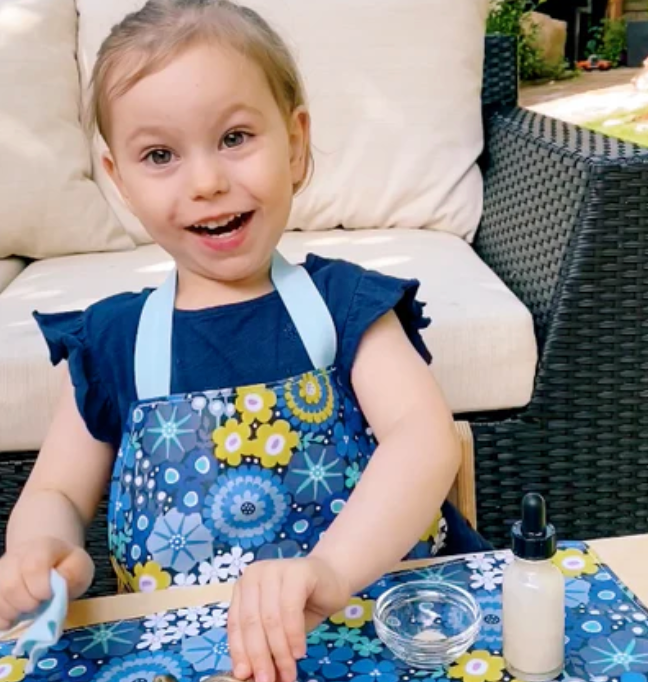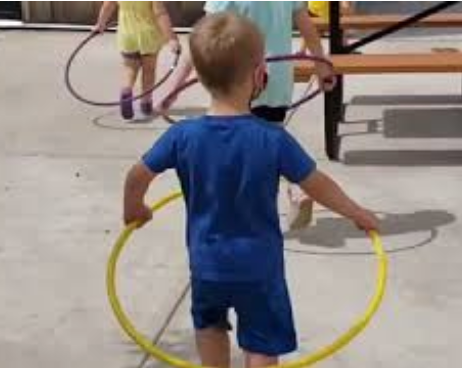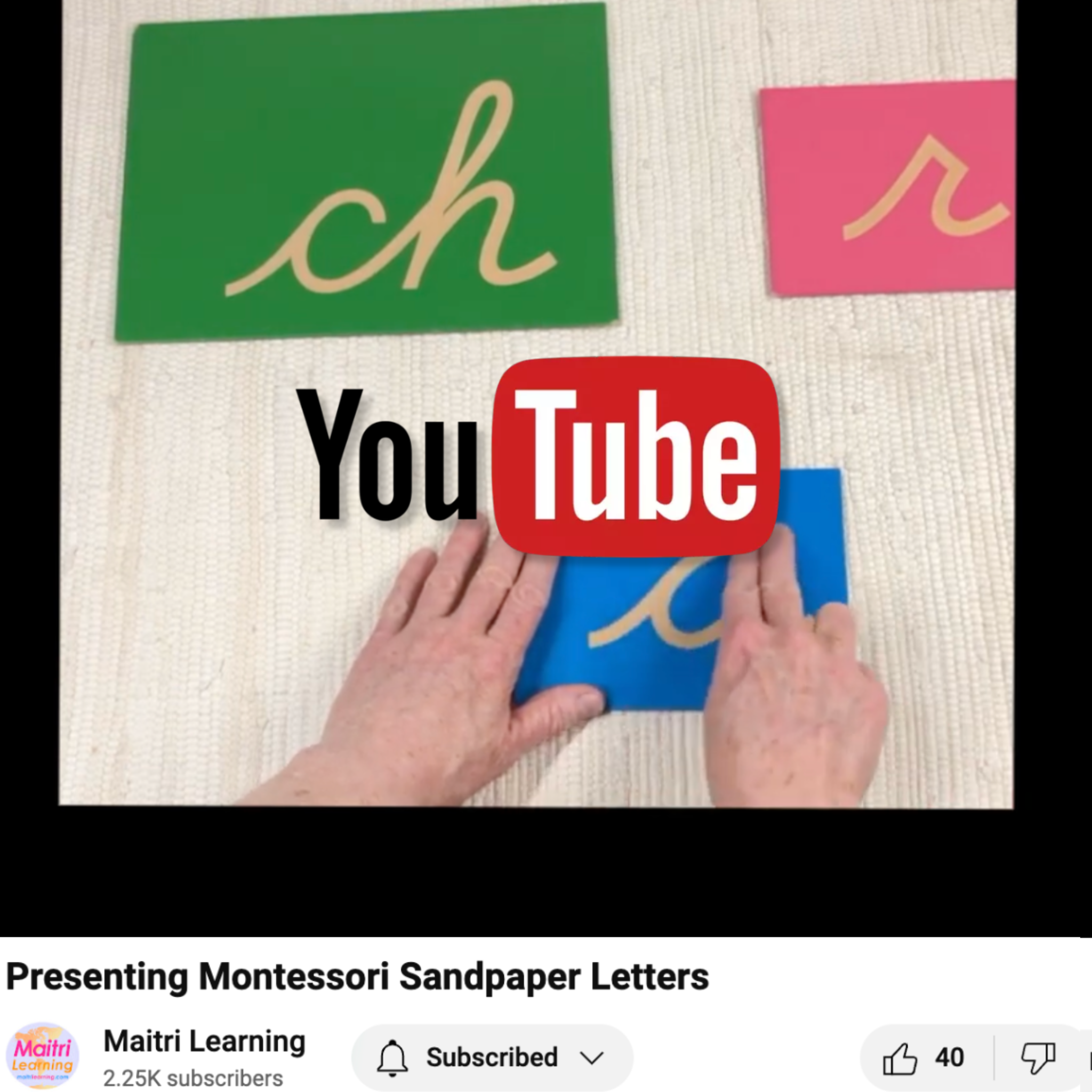Face shields instead of masks for early childhood
This week, I have spoken with and heard from many teachers/school owners who are struggling with how to reopen school for fall (that's just a few weeks away in many states). Trying to sort through federal guidance from places like the CDC and State Education Departments is cumbersome, confusing, and leaves one with more questions than answers.
One big question is the use of face masks. Is it developmentally appropriate to use face masks in early childhood settings? Are face shields for young children and their caregivers a better option?
Note: The photos are from Wish and DuoKids but many other child-size face shield vendors exist. According to the CDC, the face shield should extend from ear to ear and below the chin (CDC, June 28, 2020). You also want to test it yourself to make sure it doesn't create a visual challenge because of its curve.
The Challenge of Face Masks
First, let me clarify that face masks are necessary for protecting the public health from COVID-19 in community settings. Face masks are recommended by the CDC. Adults and children should wear them when they are out and about. This is common sense.
Evidence-base. Next, let's also highlight the near total lack of clinical research to support this recommendation (Howard, et al., 2020). A recent review of the existing evidence-base concluded that:
"The evidence is not sufficiently strong to support widespread use of facemasks as a protective measure against COVID-19. However, there is enough evidence to support the use of facemasks for short periods of time by particularly vulnerable individuals when in transient higher risk situations. " (Brainard, et al., 2020)
Just because the evidence is inconclusive so far does not mean that face masks don't work! It could just be that no one has undertaken a really good clinical study yet to answer the question. So, in the absence of direct clinical evidence, we have to rely on indirect and circumstantial evidence along with logic. This is true for face masks and, as I will argue, should be true for face shields as well.
Face masks and early childhood. The CDC recognizes the challenges of face masks in early childhood classrooms.
"Younger children (e.g., preschool or early elementary aged) may be unable to wear a cloth face covering properly, particularly for an extended period of time. Wearing of cloth face coverings may be prioritized at times when it is difficult to maintain a distance of 6 feet from others (e.g., during carpool drop off or pick up, or when standing in line at school)." (CDC, June 28, 2020)
As the CDC notes, we can't expect young children to wear masks all day long at school. Even at the grocery store you see that young children are often adjusting their masks, their noses are popping out, the masks sag or don't fit well, or they are touching their face either through or beneath the mask.
So, what would it look like if we follow the above guidance? We can space out the children's work areas and require them to wear masks only when they are not at their work area. As soon as they are ready to move away from their work, the face mask needs to go on. That sounds workable.
The challenges of the above scenario are threefold. Read on.
Auto-inoculation. Auto- or self-inoculation means infecting one's self. Young children may not be able to wash/sanitize their hands before/after touching their face and mask. Take the above example. The child gets their school work (touching things in the process), goes to their work area, and with great relief removes their mask. Their hands have been all over the classroom and now everything that was on their hands is now on their mask and face. Then, they do their work, finish up, and put their mask back on. So, if they touched a surface with COVID-19, they may have put that virus right on their face. Ugh!
And then, of course, there is the adult vigilance required to make sure all these little 3-year-olds remember to follow the mask procedure. I'm anticipating more than one toileting accident initiated by an adult graciously reminding a child to put on their mask while the child is dashing to the restroom.
Impaired breathing. The CDC does not recommend that masks be worn by anyone who has difficulty breathing. This may be an issue for patients with asthma, as noted by Kim and colleagues (2020):
"In some patients with asthma, wearing a face mask can lead to further difficulty in breathing, but it is important to wear a mask when visiting medical facilities and enclosed public space such as locker rooms and elevators, or when new respiratory symptoms occur." (Kim, Jin, & Kim, 2020)
I don't know what you are seeing in your classrooms, but you're likely encountering plenty of children with asthma (Pakkasela, 2020). This is particularly true in some neighborhoods with higher rates of air pollution (Alexander & Curry, 2017). In Canada, the incidence of childhood asthma is between 10% and 16% (Parsons, Beach, & Senthilselvan, 2017). That means for every 10 children in your group, 1 or 2 of them likely has asthma, whether they know it or not.
We know that it is during early childhood, often at the behest of teachers, that children get evaluated for and diagnosed with many things. The problem here is that the asthmatic children in your classroom might not yet be diagnosed. We might not notice that they are having trouble breathing only that they seem lethargic. The possibility of missing this is quite risky in my view.
Speech perception and facial emotion. Aside from the potential safety limitation of masks in early childhood, there is the question of developmental appropriateness. Face masks hide the mouth from view. Children rely on visual cues from the mouth while learning their language (Kaganovich & Schumaker, 2014; Lewkowicz & Hansen-Tift, 2012) and when interpreting emotion (Hoonhorst, 2011; Leitzke & Pollak, 2016). Learning language and social emotional awareness are two critical aspects of early childhood development (visit the Harvard Center on the Developing Child's website for great resources on this topic). We have no idea what face mask use by early childhood teachers let alone classmates will mean for a child's long-term development in these areas. The possible negative consequences are daunting.
Transparent Face Masks
The possibility of using a transparent face mask is exciting and may overcome the limitations of traditional face masks for adults in the early childhood setting. Unfortunately, at present, there are some limitations either in terms of expense, availability, breathability, fogging, and/or not being reusable. If your budget allows it, I would try the LEAF Mask for early childhood educators; unfortunately, it's not available until at least September, 2020. Until the kinks of transparent masks are worked out, I believe face shields may provide the most workable option.
The Face Shield Alternative
As you can see in the video from the AFP News Agency (linked below), these are being widely used in Japan.

Evidence-base. As of June 28, 2020, the CDC does not recommend face shields as a substitute for cloth face masks (CDC, June 28, 2020). As they note, there is just not much research to demonstrate their efficacy.
However, there is some research that they don't mention. Take a look at the compelling editorial in the Journal of the American Medial Association (JAMA) by Dr. Eli N. Perencevich. It reviews the existing evidence and explains why face shields should be employed widely to help stop the spread of COVID-19.
"In a simulation study, face shields were shown to reduce immediate viral exposure by 96% when worn by a simulated health care worker within 18 inches of a cough.10 Even after 30 minutes, the protective effect exceeded 80% and face shields blocked 68% of small particle aerosols,10 which are not thought to be a dominant mode of transmission of SARS-CoV-2 [COVID-19]. When the study was repeated at the currently recommended physical distancing distance of 6 feet, face shields reduced inhaled virus by 92%,10 similar to distancing alone, which reinforces the importance of physical distancing in preventing viral respiratory infections." (Perencevich, 2020).
A more recent paper published July 7, 2020 found more evidence to support the use of face shields (Ronan, et al., 2020). Their simulation research suggests that face shields are at least as effective as face masks and may be more effective in some ways.
"For droplets larger than 3μm by diameter, the efficiency of shields to block cough droplets was found to be comparable to that of regular medical masks, with enhanced protection on face parts the mask does not cover. Additionally, for finer particles, of the order 0.3 to few microns, a shield was found to perform even better, blocking about 10 times more fine particles than the medical mask." (Ronan, et al., 2020).
Put together, this suggests that face shields do an imperfect but adequate job of preventing the spread of infection; just like face masks. So our primary concern of efficacy is met.
Developmental appropriateness. As noted by Dr. Perencevich, a face shield, "...allows visibility of facial expressions and lip movements for speech perception." (Perencevich, 2020). So, these two critical components of early childhood education are not impeded.
Auto-inoculation. With face shields, as with face masks, children can touch their faces. However, since they are not required to take the face shield off and on many times during the day, the need to do so is reduced.
Also, with a mask, we may be touching our mask often in order to reposition it (those things are always shifting and sagging). If we need to reposition the face shield, we will touch the headband, not our face.
Finally, wearing the face shield itself acts as a control of error reminding us not to touch our face. When we go to scratch that itch, we bump into the face shield. This doesn't mean we can't scratch, it just reminds us that we need to make sure our hands are clean before and after we do so. The barrier tells us that the face needs extra protection from the virus.
Breathing. When you wear a face shield, your own exhalations warm the air inside the shield. I have found this less obstructive than the heat and breathing limitations of masks. I don't have data to back this up, though, so you should verify for yourself.
Visual acuity. A possible challenge of face shields is that they may alter visual perception if their curve is too tight. You should buy one shield and test it for yourself first to make sure this is not an issue. I've found that different shields have quite different results!
A note on glasses. If you wear glasses, you know how tricky it is to keep them from fogging up when you wear a mask. I keep blaming the mask design but it seems to happen with every mask I try. When I wear my glasses under a face shield, I have no problem with fogging. Again, this is not exactly a rigorous clinical study, it's just my experience so you should test this one for yourself.
In sum, with face shields we likely get reduced transmission without impeding lip movements, facial expression, or breathing. I suggest that based on available evidence and the lack of availability of effective transparent masks, face shields are the best option for both young children and the adults who care for them in early childhood settings.
But this is all theoretical. What we really need is more clinical research coupled with the experience of people on the ground. So, please add your thoughts and experiences to the comments below so we can all benefit from your knowledge. We're going to need to pull together the intelligence of the whole world to help us get through this one!
Postscript: Two days after writing this, I learned of an article in the Wall Street Journal that corroborates much of what is presented above. If you need more evidence to present to your licensing agency, print that Journal article out too!
References
AFP News Agency. (June 5 2020). Japanese students go back to school with face shields: AFP. Available at https://www.youtube.com/watch?v=IKysxviWZlU
Alexander, D., & Currie, J. (2017). Is it who you are or where you live? Residential segregation and racial gaps in childhood asthma. Journal of health economics, 55, 186-200.
Brainard, J. S., Jones, N., Lake, I., Hooper, L., & Hunter, P. (2020). Facemasks and similar barriers to prevent respiratory illness such as COVID-19: A rapid systematic review. medRxiv.
Centers for Disease Control and Prevention (CDC) (April 21, 2020). Guidance for childcare programs that remain open. National Center for Immunization and Respiratory Diseases (NCIRD), Division of Viral Diseases.
Centers for Disease Control and Prevention (CDC) (June 28, 2020). Considerations for wearing cloth face coverings. National Center for Immunization and Respiratory Diseases (NCIRD), Division of Viral Diseases.
Hoonhorst, I., Medina, V., Colin, C., Markessis, E., Radeau, M., Deltenre, P., & Serniclaes, W. (2011). Categorical perception of voicing, colors and facial expressions: A developmental study. Speech Communication, 53(3), 417-430.
Howard, J., Huang, A., Li, Z., Tufekci, Z., Zdimal, V., van der Westhuizen, H. M., ... & Tang, V. (2020). Face masks against COVID-19: an evidence review.
Kaganovich, N., & Schumaker, J. (2014). Audiovisual integration for speech during mid-childhood: Electrophysiological evidence. Brain and language, 139, 36-48.
Kim, S., Jin, H. J., & Kim, S. R. (2020). Management of Severe Asthma During the COVID-19 Pandemic in Korea. Allergy, Asthma & Immunology Research, 12(5), 897-901.
Leitzke, B. T., & Pollak, S. D. (2016). Developmental changes in the primacy of facial cues for emotion recognition. Developmental psychology, 52(4), 572.
Lewkowicz, D. J., & Hansen-Tift, A. M. (2012). Infants deploy selective attention to the mouth of a talking face when learning speech. Proceedings of the National Academy of Sciences, 109(5), 1431-1436.
Pakkasela, J., Ilmarinen, P., Honkamäki, J., Tuomisto, L. E., Andersén, H., Piirilä, P., ... & Rönmark, E. (2020). Age-specific incidence of allergic and non-allergic asthma. BMC pulmonary medicine, 20(1), 1-9.
Parsons, M. A., Beach, J., & Senthilselvan, A. (2017). Association of living in a farming environment with asthma incidence in Canadian children. Journal of Asthma, 54(3), 239-249.
Perencevich, E. N., Diekema, D. J., & Edmond, M. B. (2020). Moving personal protective equipment into the community: face shields and containment of COVID-19. JAMA.










6 comments
@Abigail: Excellent question. I have no direct experience with Indigogo or the Leaf Mask. But it sure looks like it could be a good option…except that it lacks coverage for the eyes (a lot of infections can apparently enter via droplets in the eyes). The Leaf Mask is not available yet and there is no clear way to purchase it on their website. So, I think they’re not quite ready for prime-time. I would wait and check back with them in September. Hope this helps and good luck!
Julia Volkman
Thank you for this helpful article!
Have you been able to try a Leaf mask?
I was concerned about going through indigogo. I have never done that before and I wasn’t sure how likely it was that I would receive the product or that filters would be available in the future. Thoughts?
Abigail Miller
@Jan: You are welcome! That is so cool that you already made this decision. You’ll have to keep us posted on what works and what doesn’t so everyone can learn from you wicked smart people :)
Julia Volkman
@Martha: Thank you! You are part of the motivation for this post. I’ve been thinking about it for some time but being on the call with you and everyone else Wednesday really lit a fire under me to get it done! Let’s hope it helps. We need so much help to figure this out!
Julia Volkman
Julia—Thanks so much for doing the research which actually verifies our decision to have all of our staff and our elementary children wear face shields. I so appreciate you and all that you do for our Montessori community.
Jan Malkar
Thanks very much for this very informative, research-based article on face shields!
We are about to open our summer session, and I appreciate the timely information. So many parents are uncomfortable with their young children wearing face masks for much of the day, and I understand why.
Again, many thanks,
Martha Torrence
Head of School
Summit Montessori School
Framingham, MA
Martha Torrence
Leave a comment
This site is protected by hCaptcha and the hCaptcha Privacy Policy and Terms of Service apply.